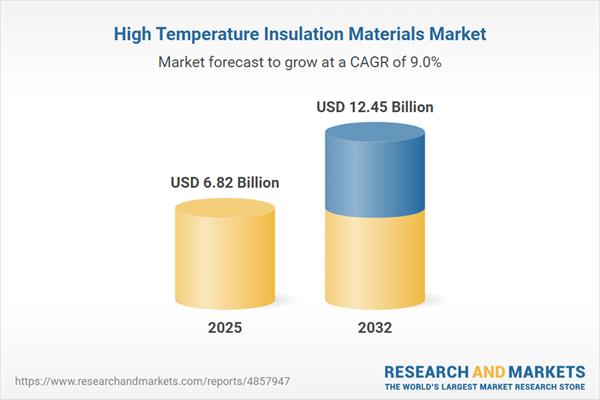Speak directly to the analyst to clarify any post sales queries you may have.
High temperature insulation materials are essential for organizations seeking to maintain operational stability in demanding industrial environments. These solutions help safeguard equipment, ensure regulatory compliance, and support risk management objectives for senior decision-makers.
Market Snapshot: High Temperature Insulation Materials
The global high temperature insulation materials market is undergoing consistent expansion, currently valued at USD 6.27 billion in 2024. The market is forecast to reach USD 6.82 billion by 2025 and USD 12.45 billion by 2032, underscoring persistent investment from manufacturing, power generation, and other industrial sectors. Growth is propelled by advancements in thermal barrier technologies and increasing compliance requirements under new energy and environmental standards. Organizations integrating advanced insulation benefit from extended asset service life, improved maintenance schedules, and greater uptime. This expansion highlights the strategic importance of high temperature insulation materials in aligning operational performance with evolving regulatory expectations.
Scope & Segmentation of the High Temperature Insulation Materials Market
This report delivers actionable insight for executives overseeing procurement and asset protection in high-risk thermal settings, outlining market segmentation essential for strategic planning.
- Product Forms: Blankets, blocks, boards, granules, modules, and paper enable flexible installation, supporting both new projects and retrofits in complex operational environments.
- Material Types: Aerogel, calcium silicate, ceramic fiber, foam glass, and refractory brick provide targeted compatibility with safety standards and varying process conditions.
- Temperature Ranges: Solutions cater to applications up to and above 1400°C, allowing continuous operation and protection for assets in both routine and extreme service.
- Installation Types: Options include flexible and rigid systems, supporting project-specific engineering choices and offering adaptability to site and budget requirements.
- End Use Industries: Cement and lime, glass and ceramics, iron and steel, petrochemicals and refining, and power generation rely on these materials to prioritize uptime, safety, and compliance in high-temperature operations.
- Regions: The Americas, Europe, Middle East and Africa, and Asia-Pacific are covered with analysis tailored to their regulatory climates and infrastructure, addressing supply chain and investment priorities.
- Notable Companies: Morgan Advanced Materials PLC, 3M Company, Unifrax I LLC, Saint-Gobain S.A., Johns Manville Corporation, RPM International Inc., Nutec Group Pty Ltd, Resco Products Inc., Carborundum Universal Limited, and ZIRCAR Ceramics Inc. continue to evolve their offerings to meet diverse compliance and operational goals.
Key Takeaways for Senior Decision-Makers
- Recent technology advances in aerogel and ceramic fiber insulation are elevating standards for equipment protection and operational reliability.
- Sourcing strategies are increasingly shaped by sustainability imperatives, with a heightened focus on recycled and low-carbon insulation solutions for improved environmental outcomes.
- Integration of digital monitoring and predictive analytics enables earlier detection of performance issues, facilitating proactive maintenance and reduced risk of equipment failure.
- Flexible and modular insulation design supports swift adaptation to updated regulatory policies and shifting process demands, making operations more resilient.
- Collaboration is expanding between manufacturers, technology providers, and compliance experts, giving operators structured guidance for addressing safety and regulatory obligations.
Tariff Impact on High Temperature Insulation Materials Supply Chains
Recent U.S. tariff revisions have added new complexity to sourcing, compelling organizations to strengthen relationships with domestic suppliers and review production footprints. Near-shoring and flexible inventory strategies are increasingly prioritized to maintain consistent supply and reduce vulnerability to market shifts.
Methodology & Data Sources
This market analysis builds on executive interviews, a thorough review of both proprietary and public datasets, and the insights of regulatory compliance specialists. Findings are triangulated to reflect conditions and strategic priorities relevant to sector leaders.
Why This Report Matters
- Provides a structured framework to evaluate high temperature insulation materials amid regulatory and market changes, streamlining procurement decision-making.
- Delivers region-sensitive intelligence and guidance that supports precise, sustainable operational planning and reveals opportunities for compliance and supply continuity.
- Enables organizations to enhance asset management practices in complex environments, proactively addressing compliance and operational longevity.
Conclusion
This report offers senior executives the focused analysis needed to adapt to the evolving landscape of high temperature insulation materials. It supports agile responses to regulatory and operational shifts while maintaining strategic clarity.
Additional Product Information:
- Purchase of this report includes 1 year online access with quarterly updates.
- This report can be updated on request. Please contact our Customer Experience team using the Ask a Question widget on our website.
Table of Contents
3. Executive Summary
4. Market Overview
7. Cumulative Impact of Artificial Intelligence 2025
Companies Mentioned
The companies profiled in this High Temperature Insulation Materials market report include:- Morgan Advanced Materials PLC
- 3M Company
- Unifrax I LLC
- Saint-Gobain S.A.
- Johns Manville Corporation
- RPM International Inc.
- Nutec Group Pty Ltd
- Resco Products, Inc.
- Carborundum Universal Limited
- ZIRCAR Ceramics, Inc.
Table Information
| Report Attribute | Details |
|---|---|
| No. of Pages | 190 |
| Published | October 2025 |
| Forecast Period | 2025 - 2032 |
| Estimated Market Value ( USD | $ 6.82 Billion |
| Forecasted Market Value ( USD | $ 12.45 Billion |
| Compound Annual Growth Rate | 8.9% |
| Regions Covered | Global |
| No. of Companies Mentioned | 11 |









